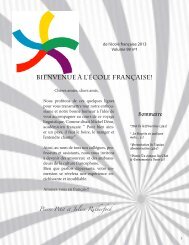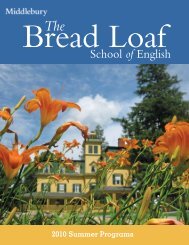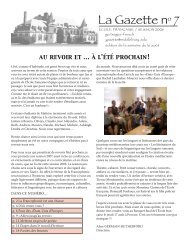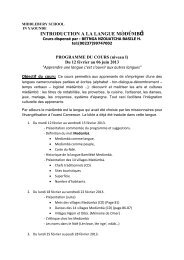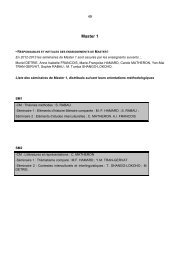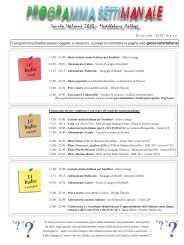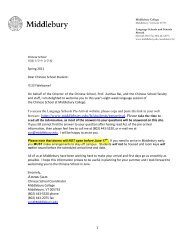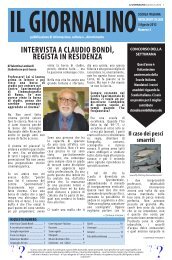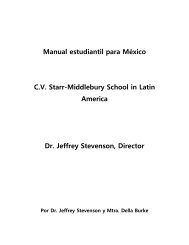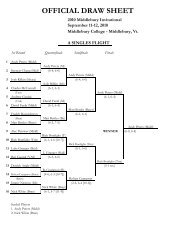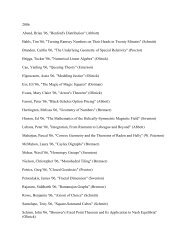2012 Summer Symposium Program - Middlebury College
2012 Summer Symposium Program - Middlebury College
2012 Summer Symposium Program - Middlebury College
You also want an ePaper? Increase the reach of your titles
YUMPU automatically turns print PDFs into web optimized ePapers that Google loves.
Page 16<br />
18<br />
Lauren Pincus ‘14<br />
Major: CHEM, GEOL<br />
Gretchen Augat Reilly ‘60<br />
Environmental Studies Fund<br />
Peter Ryan<br />
Professor of Geology<br />
19<br />
Nathan Rudd ‘13<br />
Major: CHEM<br />
National Science Foundation<br />
(Larrabee)<br />
Jim Larrabee<br />
William R. Kenan Jr. Professor<br />
of Chemistry<br />
<strong>Middlebury</strong> <strong>Summer</strong> Research <strong>Symposium</strong> <strong>2012</strong><br />
Phosphorus Abundance and Reactivity in<br />
Champlain Valley Sediments: Implications for<br />
Nutrient Transport to Lake Champlain<br />
Lauren Pincus and Peter Ryan<br />
Department of Geology, <strong>Middlebury</strong> <strong>College</strong>, <strong>Middlebury</strong> VT 05753<br />
Phosphorus is the main limiting nutrient responsible for eutrophication and toxic<br />
algal blooms in Lake Champlain, and in order to model P transport from the<br />
basin to the lake, a better understanding of P concentrations across the basin is<br />
necessary. Research and modeling efforts thus far have mainly focused on the<br />
release of phosphorus from point sources such as sewage treatment plants and from<br />
agricultural non-point sources; however, data is needed on P release from natural<br />
sources, especially eroding stream beds and lake shore deposits in order to accurately<br />
model the transport of P to Lake Champlain. This project seeks to collect data on<br />
P abundance in non-point sources such as river floodplains, eroding cut banks, and<br />
forest soils. Soil, sand, and clay samples have been collected at sites along multiple<br />
tributaries to the southern and central parts of Lake Champlain. X-ray diffraction<br />
was used to understand the mineralogical composition of collected samples. Relative<br />
amounts of the minerals were measured with particular importance placed on<br />
minerals with the potential to adsorb P such as smectite and iron hydroxides. This<br />
data provides insight into which minerals are present in clays, sands, and soils to<br />
release phosphorus or hold it in an insoluble form. Comparisons between weathered<br />
and unweathered samples can also potentially indicate which minerals may be<br />
preferentially weathering to release phosphorus. Research will continue with<br />
measurements of total P using LiBO 2 fusion and ICP-AES analysis of the samples.<br />
Additionally available P will be extracted and measured using sodium bicarbonate or<br />
another extractant.<br />
Characterization of 4- and 5-coordinate<br />
Co(II) Model Complexes by Magnetic Circular<br />
Dichroism Spectroscopy<br />
Nathan Rudd and Jim Larrabee<br />
Department of Chemistry & Biochemistry, <strong>Middlebury</strong> <strong>College</strong>, <strong>Middlebury</strong> VT 05753<br />
The determination of zero-field splitting (ZFS) parameters provides valuable<br />
insight into the geometric and electronic structure of metalloenzyme active sites.<br />
Variable-temperature, variable-field magnetic circular dichroism (VTVH MCD)<br />
sheds light on the phenomenon of ground-state zero-field splitting, as well as a basis<br />
for investigating paramagnetic metal-containing enzyme active sites to see how<br />
structure correlates with mechanisms. VTVH MCD spectroscopy has been applied



